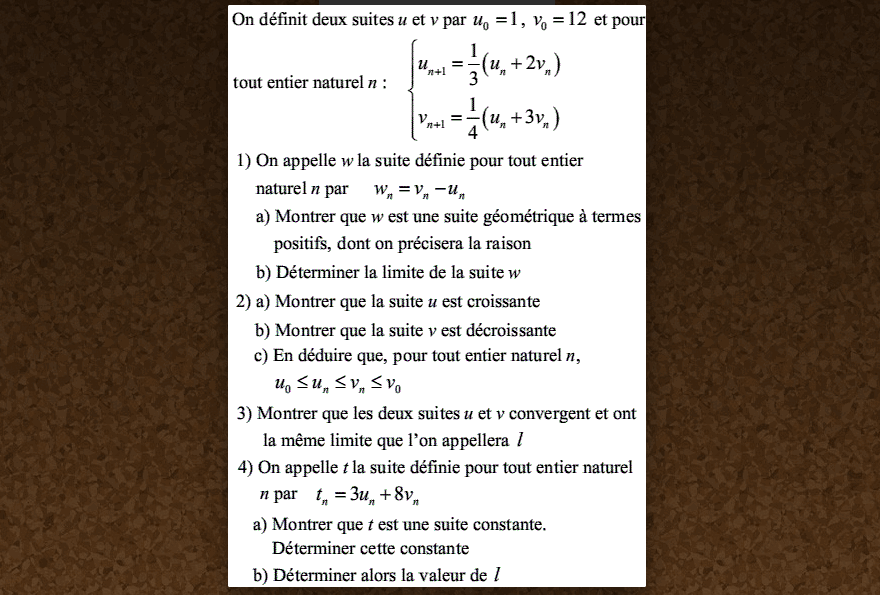
Devoir de synthèse n°1 2019 4ème Sciences Expérimentales
Exercice N°1

Pour chaque question, une seule réponse est correcte. On indiquera sur la copie le numéro de la question et la lettre correspondante à la réponse choisie. Aucune justification n'est demandée.
-
1$°$)
La forme exponentielle du nombre complexe $-2e^{-\mathrm{i}\frac{\pi }{5}}$
est :
-
(b) $2e^{\mathrm{i}\frac{4\pi}{5}}$.
$\begin{eqnarray} -2e^{-\mathrm{i}\frac{\pi }{5}}&=&2e^{\mathrm{i}\pi}.e^{-\mathrm{i}\frac{\pi }{5}} \\ &=& 2e^{\mathrm{i}\frac{4\pi}{5}} \end{eqnarray}$
Donc$(\text{b})\, \, \, -2e^{-\mathrm{i}\frac{\pi }{5}}=2e^{\mathrm{i}\frac{4\pi}{5}}$.- 2$°$) L'ensemble des points $M(z)$ tels que
$z=\mathrm{i}-e^{\mathrm{i}\theta }$ où $ \theta \in \mathbb{R}$ est :-
(b) un cercle.
Soit $A$ le point d'affixe $\mathrm{i}$ alors :
$\begin{eqnarray} z=\mathrm{i}-e^{\mathrm{i}\theta}&\Longleftrightarrow& z - \mathrm{i}=-e^{\mathrm{i}\theta}\\ &\Longleftrightarrow& z_M-z_A=-e^{\mathrm{i}\theta} \end{eqnarray}$
alors $|z_M-z_A|=|-e^{\mathrm{i}\theta}|=1$. $\Longleftrightarrow AM=1$. Donc$(\text{b})$L'ensemble des points $M(z)$ tels que
$z=\mathrm{i}-e^{\mathrm{i}\theta }$ où $ \theta \in \mathbb{R}$ est un cercle de centre $A(\mathrm{i})$ et de rayon $r=1$.
- 3$°$) Soit $f$ une fonction définie sur $\mathbb{R}$ telle que pour tout réel $x$ non nul, $-\dfrac{1}{x^{2}}-x\leq f(x)$ alors :
(a)$ \displaystyle\lim_{x\to -\infty}f(x)=+\infty$Pour tout réel $x$ non nul, $\displaystyle\lim_{x\to -\infty}-\dfrac{1}{x^{2}}-x= \displaystyle\lim_{x\to -\infty}-\dfrac{1}{x^{2}}-\displaystyle\lim_{x\to -\infty}x=0-(-\infty)=+\infty$
D'après le théorème de Limite et ordre on obtient :$ \displaystyle\lim_{x\to -\infty}f(x)=+\infty$
- 4$°$) Soit $\left( u_{n}\right) $ la suite réelle définie sur $\mathbb{N}^{\ast }$ par $\dfrac{\cos n}{n}$ alors :
(a) $ \displaystyle\lim_{n\to +\infty}u_n=0$Pour tout $n\in \mathbb{N}^*,\, \, -1\leqslant \cos n \leqslant 1$ alors :
Pour tout $n\in \mathbb{N}^*$ $-\dfrac{1}{n}\leqslant \dfrac{\cos n}{n} \leqslant \dfrac{1}{n}$ de plus
$\displaystyle\lim_{n\to +\infty}-\dfrac{1}{n}=\displaystyle\lim_{n\to +\infty}\dfrac{1}{n}=0$ alors $\displaystyle\lim_{n\to +\infty}\dfrac{\cos n}{n}=0$ Donc :$(\text{a})$
$ \displaystyle\lim_{n\to +\infty}u_n=0$Exercice N°2
-
1
- (a)
Résoudre dans $\mathbb{C}$ l'équation : $z^{2}-2\sqrt{3}z+4=0$.
On a $\Delta =(-2\sqrt{3})^2-4\times 1\times 4=-4$ alors : $$z_1=\dfrac{2\sqrt{3}-2\mathrm{i}}{2}=\sqrt{3}-\mathrm{i}$$ $$z_2=\dfrac{2\sqrt{3}+2\mathrm{i}}{2}=\sqrt{3}+\mathrm{i}$$ Donc :
$S_{\mathbb{C}}=\left\{ \sqrt{3}-\mathrm{i}; \sqrt{3}+\mathrm{i} \right\}$
- (b)
Ecrire les solutions sous forme exponentielle.
$\begin{eqnarray} \sqrt{3}-\mathrm{i}&=&2\left( \dfrac{\sqrt{3}}{2}-\dfrac{1}{2}\mathrm{i} \right)\\ &=&2\left( \cos -\dfrac{\pi}{6} +\mathrm{i}\sin -\dfrac{\pi}{6} \right)\\ &=&2e^{-\mathrm{i}\frac{\pi}{6}} \end{eqnarray}$ et $\begin{eqnarray} \sqrt{3}+\mathrm{i}&=&2\left( \dfrac{\sqrt{3}}{2}+\dfrac{1}{2}\mathrm{i} \right)\\ &=&2\left( \cos \dfrac{\pi}{6} +\mathrm{i}\sin \dfrac{\pi}{6} \right)\\ &=&2e^{\mathrm{i}\frac{\pi}{6}} \end{eqnarray}$
Donc :
- $\colorbox{yellow}{$z_1=2e^{-\mathrm{i}\frac{\pi}{6}}$}$
- $\colorbox{yellow}{$z_2=2e^{\mathrm{i}\frac{\pi}{6}}$}$
- (a)
Résoudre dans $\mathbb{C}$ l'équation : $z^{2}-2\sqrt{3}z+4=0$.
-
2
Pour tout $z\in \mathbb{C}$ on pose : $P(x)=z^{3}-2\left( \sqrt{3}+\mathrm{i} \right) z^{2}+4\left( 1+\mathrm{i}\sqrt{3} \right)z-8i$.
- (a)
Montrer que le nombre complexe $z_{0}=2\mathrm{i}$ est une racine de l'équation $P(x)=0.$
$\begin{eqnarray} P(2\mathrm{i})&=&(2\mathrm{i})^{3}-2\left( \sqrt{3}+\mathrm{i} \right) (2\mathrm{i})^{2}+4\left( 1+\mathrm{i}\sqrt{3} \right)(2\mathrm{i})-8i\\ &=&(-8\mathrm{i})-2\left( \sqrt{3}+\mathrm{i} \right) (-4)+4\left( 1+\mathrm{i}\sqrt{3} \right)(2\mathrm{i})-8i\\ &=&-\cancel{8\mathrm{i}}+\bcancel{8\sqrt{3}}+\cancel{8\mathrm{i}}+\cancel{8\mathrm{i}}-\bcancel{8\sqrt{3}}-\cancel{8\mathrm{i}} \\ &=&0 \end{eqnarray}$
Donc :
$z_0=2\mathrm{i}$ est une solution de l'équation $P(x)=0$.
- (b)
En déduire les solutions dans $\mathbb{C}$ de l'équation $P(x)=0.$
$P(2\mathrm{i})=0$ alors $P$ est factorisable par $(z-2\mathrm{i})$. Alors :
Il existe un polynôme $Q$ tel que $P(x)=(z-2\mathrm{i})Q(z)$
d'après l'algorithme de Horner on a :
$\newcommand\T{\Rule{0pt}{1em}{.3em}} \begin{array}{|c|c|c|c|c|} \hline P \T & 1 & -2(\sqrt{3}+\mathrm{i}) & 4(1+\mathrm{i}\sqrt{3}) & -8\mathrm{i} \\\hline 2\mathrm{i} \T & & 2\mathrm{i} & -4\mathrm{i}\sqrt{3} & 8\mathrm{i} \\\hline Q \T & \colorbox{yellow}{$1$} & \colorbox{yellow}{$-2\sqrt{3}$} & \colorbox{yellow}{$4$} & 0 \\\hline \end{array}$
Alors $$Q(z)=\colorbox{yellow}{$1$}z^2\colorbox{yellow}{$-2\sqrt{3}$}z+\colorbox{yellow}{$4$}$$ $$P(z)=0 \Longleftrightarrow (z-2\mathrm{i})(z-\sqrt{3}+\mathrm{i})(z-\sqrt{3}-\mathrm{i})=0$$ Donc :$S_{\mathbb{C}}=\left\{ 2\mathrm{i}; \sqrt{3}-\mathrm{i}; \sqrt{3}+\mathrm{i} \right\}$
- (a)
Montrer que le nombre complexe $z_{0}=2\mathrm{i}$ est une racine de l'équation $P(x)=0.$
-
3
Dans le plan muni d'un repère orthonormé direct $\left( O,\overrightarrow{u},\overrightarrow{v}\right) $ On donne les points : $A\left( \sqrt{3}- \mathrm{i} \right) ,$ $B\left( \sqrt{3}+ \mathrm{i} \right) $ et $C\left(2i\right) .$- (a) Placer les points $A,$ $B$ et $C.$
Construction de $A$ et $B$
- (b) Montrer que le quadrilatère $OABC$ est un losange.
1ère méthode
On a $z_A+z_C=\sqrt{3}-\mathrm{i}+2\mathrm{i}=\sqrt{3}-\mathrm{i}=z_B+z_O$ alors $OABC$ est un parallélogramme de plus $OA=|z_A|=2=|z_C|=OC$. Donc :
$OABC$ est un losange.
2ème méthode
On a $z_A+z_C=\sqrt{3}-\mathrm{i}+2\mathrm{i}=\sqrt{3}-\mathrm{i}=z_B+z_O$ alors $OABC$ est un parallélogramme de plus $\dfrac{z_A-z_C}{z_B}=\dfrac{\sqrt{3}-\mathrm{i}-2\mathrm{i}}{\sqrt{3}+\mathrm{i}}=-\sqrt{3}\mathrm{i}\in \mathrm{i}\mathbb{R}$ alors $(AC)\perp (OB)$. Donc :
$OABC$ est un losange.
3ème méthode
On a $|z_B-z_A|=|2\mathrm{i}|=2,\, \, \, |z_B-z_C|=|z_A|=|z_C|=2$ alors $AB=BC=OA=OC=2$ . Donc :
$OABC$ est un losange.
- (a) Placer les points $A,$ $B$ et $C.$
Exercice N°3

Correction d'exercice n°1 suite réelle 2019 4ème Sciences Expérimentales.
Exercice 1 suite réelle
Correction d'exercice n°2 suite réelle 2019 4ème Sciences Expérimentales.
Exercice 2 suite réelle
Exercice N°4
L'éspace est muni d'un repère orthonormé direct $\left( O,\overrightarrow{i},\overrightarrow{j},\overrightarrow{k}\right) .$ On considère les points $A\left( -1;0;1\right) ,$ $B\left( 1;4;-1\right) ,$ $C\left( 1;-2;-1\right) $ et $D\left( 1;-1;2\right) .$
1
Montrer que le triangle $ABC$ est rectangle en $A.$On a $\overrightarrow{AB}\begin{pmatrix} 2 \\ 4 \\ -2 \end{pmatrix}$ et $\overrightarrow{AC}\begin{pmatrix} 2 \\ -2 \\ -2 \end{pmatrix}$ alors $\overrightarrow{AB}.\overrightarrow{AC}=0$ Ainsi $\overrightarrow{AB}\perp \overrightarrow{AC}$ Donc : $ABC$ est un triangle rectangle en $A$.
2
-
(a)
Montrer que que $\overrightarrow{AB}\wedge \overrightarrow{AC}=-12%
\overrightarrow{i}-12\overrightarrow{k}.$
Produit vectoriel de deux vecteurs
Alors : $\overrightarrow{AB}\wedge \overrightarrow{AC}=-12% \overrightarrow{i}-12\overrightarrow{k}.$ -
(b)
Calculer l'aire $\mathcal{A}$ du triangle $ABC.$
L'aire d'un triangle
$\mathcal{A}=\dfrac{1}{2}\left\| \overrightarrow{AB}\wedge \overrightarrow{AC} \right\|=\dfrac{1}{2}\sqrt{(-12)^2+(-12)^2}=6\sqrt{2}$
3
Calculer le volume $\mathcal{V}$ du tétraèdre $ABCD.$Volume d'un tétraèdre
On a $\mathcal{V}=\dfrac{1}{6}\left| (\overrightarrow{AB}\wedge \overrightarrow{AC}).\overrightarrow{AD} \right|$ Puisque $\overrightarrow{AD}\begin{pmatrix} 2 \\ -1 \\ 1 \end{pmatrix}$ alors $\mathcal{V}=\dfrac{1}{6}|-12\times 2 -12\times 1|=6$4
Soit $K$ le projeté orthogonal de $D$ sur le plan $(ABC)$. Calculer la distance $DK.$On a $\mathcal{V}=\dfrac{1}{3}\mathcal{A}.DK$ alors $DK=\dfrac{3\mathcal{V}}{\mathcal{A}}=\dfrac{3\sqrt{2}}{2}$. Donc :
$DK=\dfrac{3\sqrt{2}}{2}$
- 2$°$) L'ensemble des points $M(z)$ tels que